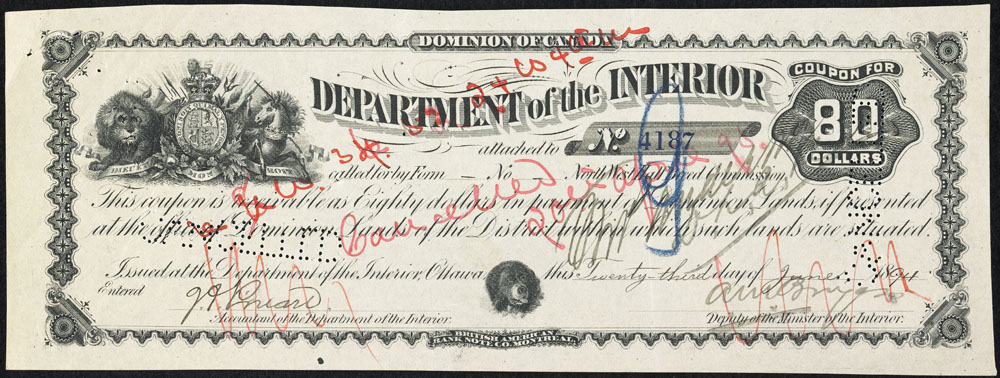1870's: Métis Scrip
Métis scrip was implemented in Manitoba to fulfil the terms of the Manitoba Act, and to extinguish Métis Aboriginal title in a way that is seen as less expensive than entering into treaty agreements. Although the Manitoba Act is ratified in 1870, scrip will not begin to be distributed till 1876. Those who qualify for a scrip coupon must choose between either 160 acres or 160 dollars if the applicant is an adult, or 240 acres or 240 dollars if the applicant is a child. Initially, scrip was only offered to Métis born before 1870.
The following timeline produced by Camie Augustus tells the story of the Métis and Scrip policy, which was used to extinquish Métis aboriginal title.
1870-1885 Métis Relocation
After 1870, discriminatory attitudes from incoming settlers towards the Métis forced hundreds of them to move into the Northwest territories (present-day Saskatchewan and Alberta), while others went to Montana and the Dakotas (United States). They founded settlements such as Wood Mountain - Willow Bunch, St. Laurent, St. Isadore de Belleville and Batoche, which augmented pre-existing Métis communities such as Cumberland House and Ile-a-la-Crosse. They continued with their livelihood of hunting buffalo, along with some farming, trapping and freighting. It is estimated that 2/3 of the approximately 10,000 Métis moved away from the Red River area.(1)
1885: Nort West Resistance
Louis Riel returns to Canada from exile in 1884 and petitions Ottawa on behalf of Métis and white settlers in the North West Territories. Continuing indifference on the part of the Canadian Government leads Riel to form a provisional government in 1885, after which Riel and his followers clash with government troops at Duck Lake in what is now Saskatchewan. Riel and his followers are defeated three months after the resistance began. This marked the end of the Métis as an independent nation. Riel is tried and found guilty of treason, and hung on November 16, 1885 in Regina.
1885-1901: Second Phase of Métis Scrip
The second phase of Métis scrip is implemented in the North-West (now Saskatchewan and Alberta). Applicants who had been ineligible during the initial implentation of scrip under the Manitoba Act (such as those born after 1870) are now eligible, although the application process is cumbersome and inaccessible.
1899-1908 Third Phase of Métis Scrip

The third phase of Métis scrip accompanies the negotiation of treaties in the north of the prairie provinces. This third phase is the first in which Métis claims are considered at the same time, rather than after, treaties are negotiated. The amount of scrip issued during this time increases to $240 or 240 acres for all recipients, regardless of age.
In total, 24,326 claims were approved by 1929. However, as noted in Augustus' timeline above, the intent of Scrip was to strip Métis of Aboriginal title to the land. And this policy succeeded in doing just that. The Scrip system and the colonial mindset of individual land ownership destroyed any semblance of Métis homeland.
< Chapter 10 Table of Contents Chapter 12 >
(1). Gaudry, A. (2009). Metis. Retrieved from: http://www.thecanadianencyclopedia.ca/en/article/metis/